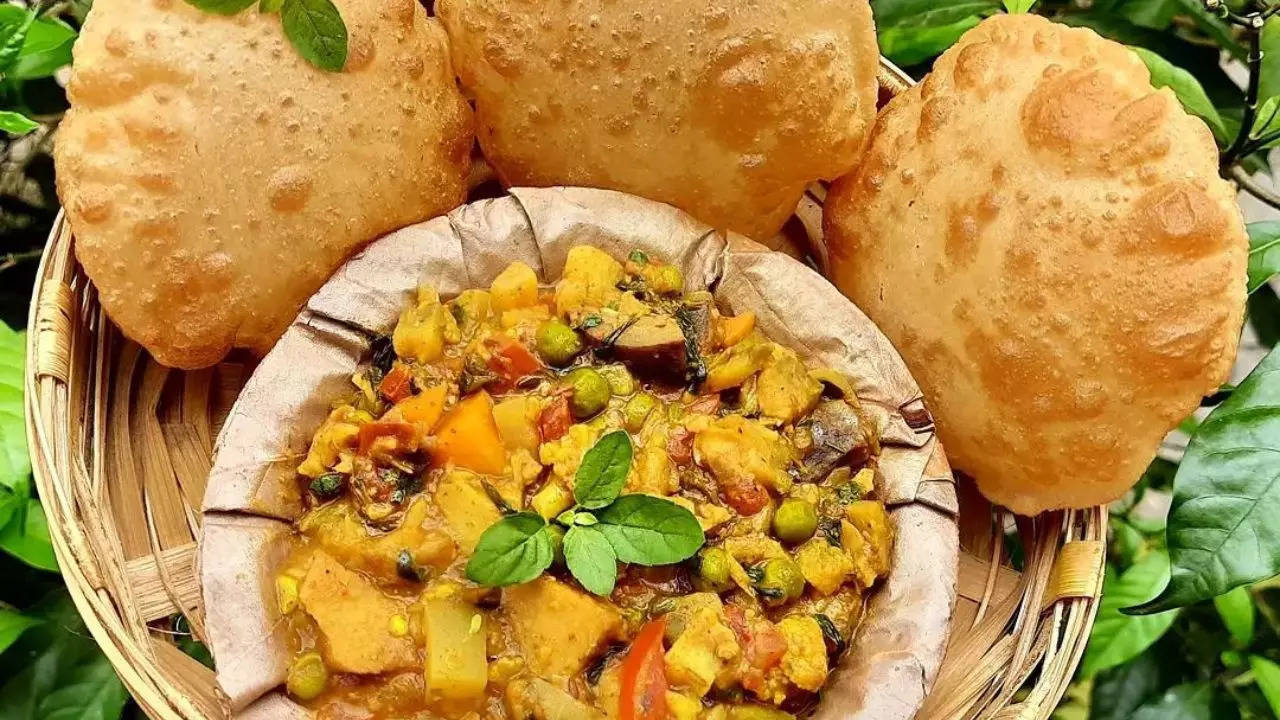
Govardhan Puja Bhog: Diwali is usually thought of as a time for sweets and shared mithais, but among the sugary treats there are also savoury dishes which hold great importance during the festival. On the occasion of Govardhan Puja which falls on the second to last day of Diwali – 2nd November this year – many families prepare a special vegetable dish, traditionally made with 56 different vegetables called Annakut Ki Sabji.
Significance Of Annakut Ki Sabji On Govardhan Puja
Govardhan Puja marks a day of gratitude to god and the community with people in the neighbourhood preparing many dishes to offer to Lord Krishna. The tradition of Annakut carries profound religious significance in Hindu culture, particularly connected to a legendary tale of Lord Krishna. According to belief, when Lord Indra unleashed devastating rains upon Vrindavan, Krishna protected its people by lifting the mighty Govardhan mountain to protect the village. Today, Annakut (“mountain of food”) celebrations honour this divine intervention through elaborate food offerings, especially prominent in regions like Rajasthan, Uttar Pradesh, Madhya Pradesh, Haryana, and Punjab.
Also Read:The Story Of Lord Krishna’s 56-Item Chappan Bhog
At the heart of this tradition lies Annakut ki sabzi, a vegetable preparation that embodies both spiritual devotion and agricultural abundance. The offering traditionally comprises either 56 or 108 different food items, symbolising the vast diversity of nature's bounty. This elaborate presentation coincides with the winter harvest, serving as a gesture of gratitude for the season's yield.
The choice of ingredients in Annakut dishes reflects Krishna's pastoral life in Vrindavan. Simple components like seasonal vegetables, and basic spices mirror the modest lifestyle of ancient rural communities. This simplicity holds special meaning, representing Krishna's time among the cowherds and emphasising the virtues of modest living and harmony with nature.
Beyond its religious significance, Annakut ki Sabji embodies the spirit of community and unity. The practice of cooking various vegetables together in a single dish symbolises the coming together of people. This celebration thus serves as both a religious observance and a reminder of the community's interconnectedness with nature and each other.
While in the temple preparations, 56 vegetables are used in honour of the festival, you can try this simplified version to offer at home.
Ingredients
Vegetables:
- 3 potatoes, peeled and cut into small pieces
- 3 small brinjals, cut into small pieces
- 1 small cauliflower, cut into florets
- 1 cup carrot, chopped
- ½ cup peas
- ½ cup broad beans, chopped
- ¼ cup radish beans, chopped
- ½ cup radish, chopped
- 1 arbi (colocasia), peeled and chopped
- 1 cup bottle gourd, chopped
- ¼ cup raw papaya, chopped
- ¼ cup sweet potato, chopped
- ¾ cup raw banana, chopped
- ¾ cup pumpkin, chopped
- 1 cup spinach, chopped
- ½ cup fresh fenugreek leaves, chopped
- 3 tomatoes, pureed
- ¾ cup fresh coriander, chopped
Spices:
- 2 inches ginger, grated
- 2-3 green chillies, finely chopped
- 3-4 tbsp oil
- 2-3 pinches asafoetida (hing)
- 1 tbsp cumin seeds
- 1 tbsp turmeric powder
- 2 tbsp coriander powder
- ¾ tbsp red chilli powder
- 2 tbsp dried mango powder (amchur)
- ½ tbsp salt (adjust to taste)
- ½ tbsp garam masala
Method
- Rinse all vegetables thoroughly and allow them to dry. Chop each vegetable as indicated. Peel and chop the arbi, bottle gourd, raw papaya, sweet potato, and raw banana.
- In a large pan, heat oil over medium flame. Add asafoetida and cumin seeds, allowing them to sizzle. Stir in turmeric powder and coriander powder, and sauté for a few seconds until fragrant.
- Add the chopped green chillies and grated ginger, and cook briefly. Mix in the chopped fenugreek and spinach, stirring until the leaves are wilted.
- Add all the chopped vegetables except the tomatoes. Stir well to coat them in the spices, then add salt and red chilli powder. Pour in 1 cup of water, cover, and simmer on low heat until the vegetables are partially tender.
- Stir in the pureed tomatoes, garam masala, dried mango powder, and chopped coriander.
- Cover and cook for another 10-15 minutes until all vegetables are fully tender and flavours are blended. Adjust seasoning as needed.Serve hot with roti or puri.

